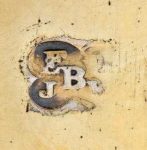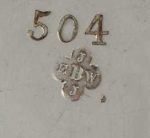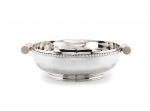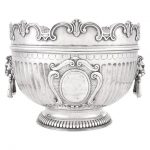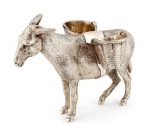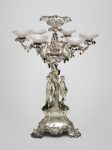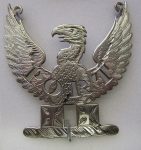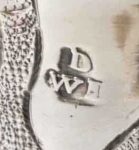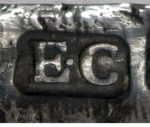Edward Barnard and Sons was a firm of British silversmiths. They created the Lily font, a large silver gilt baptismal font used in the christening services of members of the British Royal family.
The company’s origins date back to about 1680, when the silversmith Anthony Nelme (d. 1722) established a firm in Ave Maria Lane, London. Edward Barnard (d. 1855) was first manager and in 1829 became the proprietor, trading as Edward Barnard & Sons, with his sons Edward Barnard (d. 1868), John Barnard and William Barnard (d. 1851). In 1838, they moved to Angel Street, London.
The Lily font was commissioned by Queen Victoria from Edward Barnard and Sons, for the christening of her first child, Victoria, Princess Royal on 10 February 1840, her parents’ first wedding anniversary. Reference: Wikipedia
Edward, John & William Barnard Silver Makers Mark
Barnard & Sons silver makers mark
A large Art Deco silver bowl two-handle bowl by Edward Barnard & Sons Ltd, London 1937 With cylindrical ivory handles, the rim with applied notched border, retail stamp for Harrods, diameter 30cm, weight total 54oz.
Sold for £ 3,500 inc. premium at Bonhams in 2018
A VICTORIAN SILVER CENTREPIECE MARK OF JOHN, EDWARD, WALTER AND JOHN BARNARD, LONDON, 1868 On shaped circular base, cast and chased with lotus leaves and centring a cartouche with an engraved inscription, the base cast as rockwork and supporting two cast palm trees around which rest two men in Middle Eastern dress and a camel, marked on base, figures and camel, the base further stamped ‘234’ 17 ¾ in. (45 cm.) high 93 oz. (2,893 gr.) The inscription reads ‘Presented to the Rev’d Dr Benjamin Artom by the Family of the Late David Sassoon as a Token of Regard & Esteem London 27th January 1869.’
Sold for GBP 15,000 at Christies in 2018
English Sterling Silver Monteith Edward Barnard & Sons Ltd., London, 1931 The circular fluted body with lion mask and drop ring handles, the removable rim with C-scroll notches. Diameter 13 1/4 inches (33.5 cm), approximately 98 ounces.
Generally good condition overall; the bowl slightly out of round, but the crown makes right when in place; clearly and fully hallmarked; cartouche blank with erasure, but not soft nor thin from; small dents to foot rim and to the base rim of crown
Sold for $6,875 (includes buyer’s premium) at Doyle New York in 2018
A cast novelty silver double condiment in the Victorian manner, by Edward Barnard, London, 1977 Modelled as a mule with a basket strapped to either side, 17cm long, 13.2cm high, 25 oz. (775 gm.)
Sold for £1,300 at The Pedestal in 2018
In 1898, they moved to Fetter Lane, and in 1920, to Hatton Garden, London. In 1977, they became a subsidiary of Padgett & Braham, and closed in 2003.
Epergne English 1851 Marked by Edward Barnard & Sons (1829–1910)
Epergne-candelabra, with three arms, each having a threaded end to receive sockets for candleticks or glass dishes. Inscription Engraved on one side of the base, “Silver Wedding/October 4, 1851”; on another side with the hallmarks and possibly a griffin’s head; and on the third side, in script, “J L G & C E G” for John L. Gardner and his wife, Catherine Endicott (Peabody) Gardner. Markings Marked on one side of base: E J B & W in quatrefoil, lion, leopard’s head, Gothic Q date letter for 1851, female head.
Reference: Museum of Fine Arts Boston
monumental Victorian parcel-gilt silver mounted mirror-plateau/candelabrum, and a six-light candelabrum centrepiece, Edward Barnard & Sons, London, 1850-53 shaped oblong in two sections, the serpentine sides with moulded shell, scroll and rocaille borders, with cartouche and floral-garland angles, a seven-light candelabrum at each end, the foliate-scroll arms with detachable foliate sconces, a foliate support and cut-glass bowl beneath each, the sides of the plateau with four further foliate scroll supports with cut-glass bowls; the six-light candelabra formed of two detachable scrolling foliate branches each with three fruiting-vine rimmed sconces, the central detachable foliate scroll basket with pendant grape-vines and oval cut-glass bowl, two separate water-lilies each realistically chased, the main body with five detachable silver puttti holding grapes and wine cups, one proffering detachable grapes in a basket, the scroll column with grapes-vines, on a shaped foliate lozenge base with a detachable cartouche to each side, one with coat-of-arms, the other with presentation inscription: ‘PRESENTED TO W H HORNBY, ESQ. J.O. BY THE OPERATIVES OF BLACKBURN IN TOKEN OF SINCERE ESTEEM FOR HIS ZEALOUS PROMOTION OF THE BEST INTERESTS OF HIS NATIVE TOWN, HIS GENEROUS SUPPORT OF USEFUL AND CHARITABLE INSTITUTIONS AND PARTICULARLY AS THE WELL-TRIED FAITHFUL & CONSTANT FRIEND OF THE WORKING MAN, SEPT 8TH 1853’ the plateau 227cm., 89¹/² in. long overall; the centrepiece, 78.7cm., 31in. high centrepiece 13,300gr., 427oz. 12dwt.
Sold for 298,000 GBP at Sothebys in 2018
Bottle ticket with the word “PORT” (pierced lettering). Silver, pierced and engraved, upon a wreath a demi-eagle with wings displayed upon two crosses patty; chain attached.
Place of origin: London (made) Date: 1852-1853 (made) Artist/Maker: Barnard & Sons (maker)
Reference: © Victoria and Albert Museum
